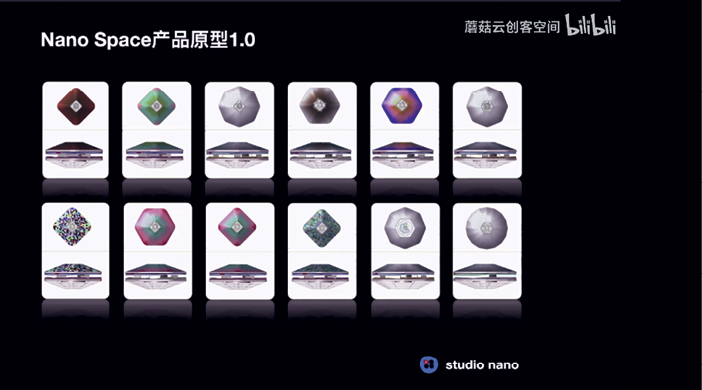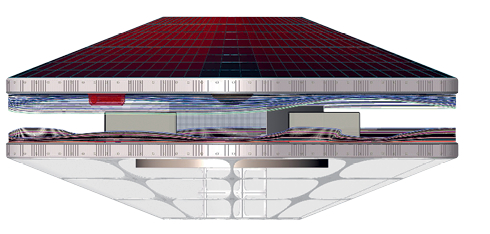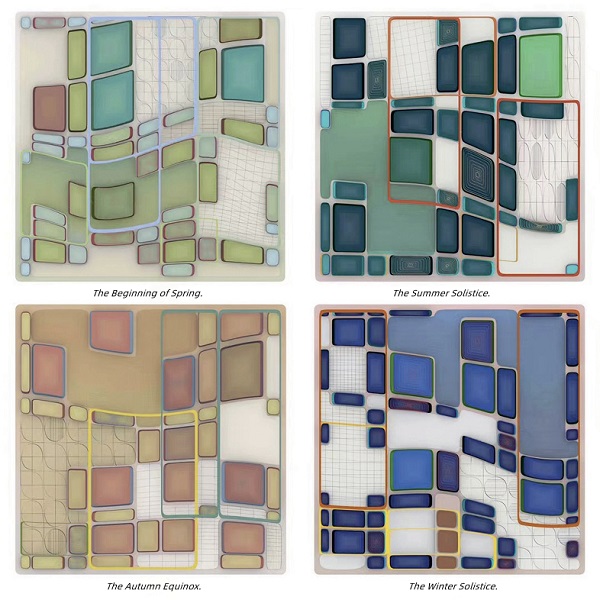We have inarguably entered the age of AI, where technology and art combine to present an inexhaustible source of art creation.

Young artists Damiao and Lucio, cofounders of Studio Nano.
People who grew up on the southeast coast of China are mostly familiar with salt fields, where salt is made. They look like square and colorful palettes on the edge of the sea. Inspired by the salt fields in their hometown of Ningbo, Zhejiang Province, young artists Damiao Wang and Lucio Lu used computer codes instead of brushes to create a range of salt field paintings.
In their body of work, a salt field is presented as 24 different paintings corresponding to the 24 solar terms in the traditional Chinese calendar. A random computer failure even brought about an unexpected aesthetical appeal to their work. This art form that introduces computer programming into artistic creation is called generative art, which the two artists are now exploring together.

Damiao introduces various forms of their virtual exhibition hall Nano Space 1.0 to audiences through livestreaming on Bilibili, a leading video platform popular among China’s younger generation.
Algorithm-Enabled Art Creation
Damiao and Lucio jointly operate an art brand, “Lucio+Damiao,” and a design studio called Studio Nano, dedicated to building a bridge between art and technology.
Lucio graduated from University College London with a master’s degree in art and design. Damiao studied architectural history, design, and art history at the University of Toronto and Harvard University. After graduation about a decade ago, she returned to China to work and then started her own business. The two were introduced to each other by a mutual friend and found they hit it off immediately.
“Before 2021, I had been working in the traditional construction industry. I worked on urban landscape and building design, and also ran a homestay business,” Damiao recalled. The Studio Nano she founded with Lucio recently became part of the incubator at Pudong Software Park.
With ChatGPT stirring a sensation worldwide, AI technology is further demonstrating how it could create solutions to problems facing humans. “Our studio is embracing the digital age. We’ve made some virtual products that incorporate virtual reality. Exploring the cutting-edge technology of digital space and its connection to daily life has been a hot topic for the entire world, and also an area of great interest to us,” said Damiao.
Studio Nano offers two types of products in virtual space design. One is customized virtual scenes, like metaverse scenes, and immersive experiences for offline events. For example, they have designed virtual exhibition halls which could not only break geographical limitations and save on construction materials, but also allow the audience to participate in an immersive, three-dimensional, and interactive virtual way, helping to give free rein to their imagination.
Nano Space 1.0 is a model product of this type. Its height, atmosphere, internal and external colors, and functions are all variable. Damiao said that once the art works to be exhibited are imported into the scene as color seeds, they will be arranged across the scene by algorithms. As a result, the exhibition hall will have an atmosphere that matches the exhibits displayed in a short period of time. From a functional perspective, when preparing an exhibition using Nano Space1.0, some practical needs of the curator, such as deciding on how many works to display and how to arrange them, can be quickly satisfied with the help of algorithms. Parameters of the Nano Space1.0 can be adjusted and edited as needed.
The creative duo has also put much energy into generative art, the other type of their design service. Generative art is an art practice that endows computers with some degree of autonomy based on predetermined systems, such as a set of natural language rules, set by the artists. Randomness is intentionally made a part of the creation of generative art, which connects the seemingly unrelated two fields of technology and art.
“Generative art is the combination of artists and computer codes – the steel and cement of the digital age. It is something new now, but will definitely become mainstream in the future,” said Damiao.
Studio Nano’s current achievement in generative art is the series of paintings inspired by salt fields. Lucio said salt fields are man-made fields for salt production, and the forming of its unique texture heavily relies on natural forces. The logic of “system + generation” with salt fields is similar to that of generative art.
“I grew up by the sea. What impressed me deeply was that the colors and texture of salt fields vary throughout the year. They are changeable in different locations, times, and seasons. Therefore, the idea of introducing salt fields’ change over time into our work occurred to me one day. That’s how our work is combined with the 24 solar terms. We used a digital approach to expressing our understanding of nature,” said Lucio. He believes the algorithm, the traditional 24 solar terms, and salt fields are combined to create abstract beauty, which is an inspirational experience for him as an artist. The series of art work always reminds him of his childhood and his hometown on the seaside.
Generative art to the two artists is a source of inspiration for them to observe and find connections between different things, expanding their cognitive boundaries as artists.

The virtual model Nano Space 1.0 can quickly change in form, appearance, and color according to code instructions.
Breaking Boundaries
After co-founding their own studio, Damiao and Lucio put all their energy into it. The two have a clear understanding of what entrepreneurship is. In their view, the mission of entrepreneurs is not to create totally brand-new things, but to find and establish connections between things that already exist. “Entrepreneurs need to be observant enough to uncover the connections between seemingly unrelated things,” they said.
Naturally, their journey is inevitably dogged by hesitation, setbacks, and weariness. Both of them said that they have thought of giving up many times, especially when there were good job opportunities available, but they resisted. Their strong passion and love for what they do, the support and encouragement from family and friends, as well as from other young entrepreneurs, inspires them to move forward.
It is not always easy to maintain the energy needed to go on, but they have found a pace and rhythm that suit them.
“We were taught when we were young that arts and sciences are two parallel paths. It seems to imply that humanities and technology are two unrelated things. However, we have come to realize that the underlying logic between them is actually the same. What we are doing now is to build the connection between mathematics, art, and colors,” said Damiao, adding that breaking one’s inherent cognitive bias is very difficult, but very important.
At the same time, the two are also breaking some stereotypes about young entrepreneurs with their own experiences.
“People may think that a typical entrepreneur is a workaholic, completely neglects family and has no personal hobbies. If you tell others that you play tennis, paint, and dive on a regular basis, people would be shocked and say that you cannot possibly operate your startup well,” said Damiao. In her eyes, an interesting entrepreneur can maintain work-life balance and live a fulfilling life. “He or she could be both an entrepreneur and an artist,” she said.
Chatting with investors about art works, Damiao always finds people’s biases toward their business. “We have met some investors and talked with them about our art projects. They found them interesting, but thought they’re too empty and too big, and hard to decide whether they are commercially viable,” said Damiao. But despite various challenges, they believe that the journey they are on itself is the reward.

Studio Nano’s generative art exploration “Salt Fields” series. They introduce four solar terms in four seasons (namely: Beginning of Spring, Summer Solstice, Autumn Equinox, and Winter Solstice) to digitally exhibit what a salt field looks like at different times of the year.
Art and Ordinary Life
Art often gives people a sense of distance, and as artists, Damiao and Lucio particularly want to break this stereotype. They constantly emphasize that art is closely related to people’s everyday life: whether a person collects art works or not, appreciating and being inspired by art are common experiences and important ways to enrich the human spirit.
They share their art work and ideas on social media platforms, such as Twitter, Bilibili and podcasts. This includes sharing inspirational thoughts on design, generative art, new technologies, Web3 and other related topics, exploring the areas where art and technology blend.
They also explore how to tap into personal potential and gain a sense of belonging in the digital age.
Damiao and Lucio hold a very optimistic attitude toward the role of AI tools in art. AI tools, such as Stable Diffusion and Chat GPT, when well used by people, can create good art.
“The dispute over AI, in my opinion, is essentially copyright disputes. The essence is more about the redistribution of benefits when something new first appears,” said Damiao. In her opinion, the solution is not to boycott AI, but to ensure that arts can get their fair share of returns when their original work was used to generate new art work. In this way, artists would be very willing to share their work with AI since it can expand their revenue streams.
Both Damiao and Lucio believe that as generative art becomes a mainstream form of art in the future, the art collection threshold will be lowered, and boundaries of entire art collections will be expanded, which means more people will have access to come into contact with and understand art.